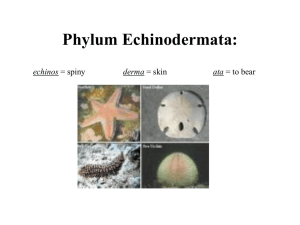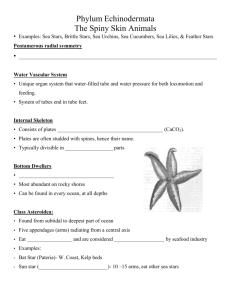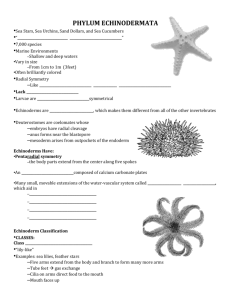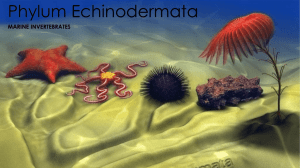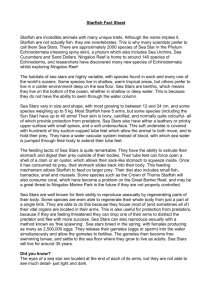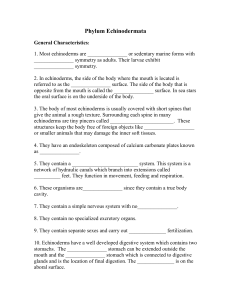Echinodermata Notes
advertisement
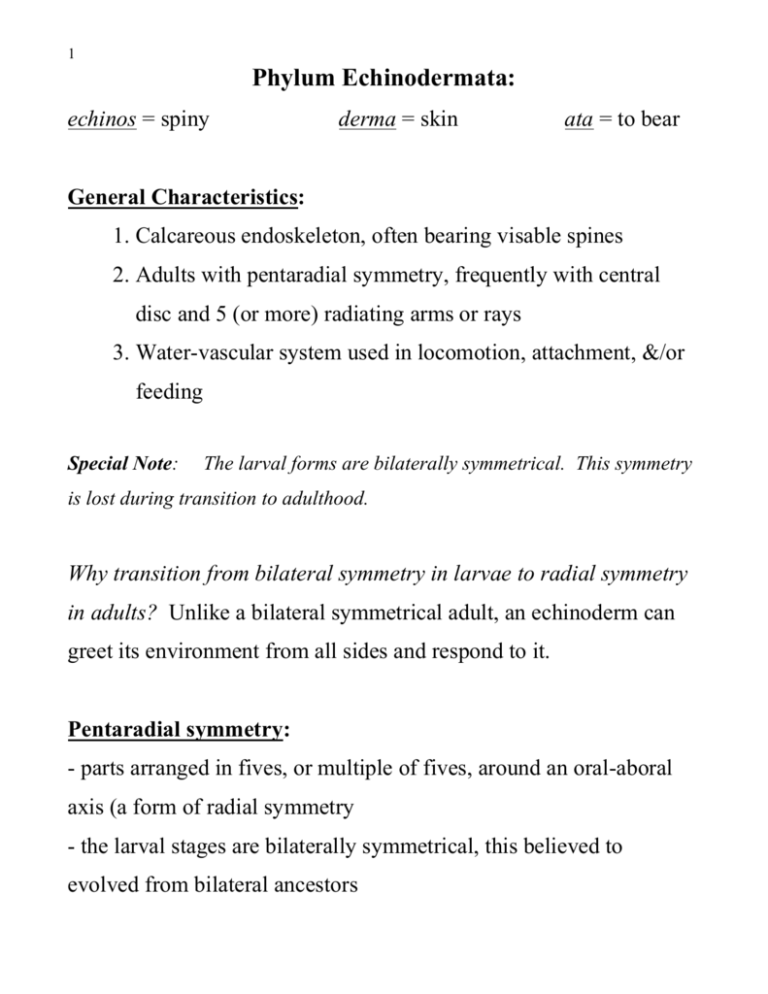
1 Phylum Echinodermata: echinos = spiny derma = skin ata = to bear General Characteristics: 1. Calcareous endoskeleton, often bearing visable spines 2. Adults with pentaradial symmetry, frequently with central disc and 5 (or more) radiating arms or rays 3. Water-vascular system used in locomotion, attachment, &/or feeding Special Note: The larval forms are bilaterally symmetrical. This symmetry is lost during transition to adulthood. Why transition from bilateral symmetry in larvae to radial symmetry in adults? Unlike a bilateral symmetrical adult, an echinoderm can greet its environment from all sides and respond to it. Pentaradial symmetry: - parts arranged in fives, or multiple of fives, around an oral-aboral axis (a form of radial symmetry - the larval stages are bilaterally symmetrical, this believed to evolved from bilateral ancestors 2 Why 5 arms instead of 6? The 5 part organization may be advantageous because joints between skeletal ossicles are never directly opposite one another, as they would be with an even number of parts. Having joints on opposite sides of the body in line with each other could make the skeleton weaker. Additions to our directional terminology: Aboral: upper surface Oral: lower surface Habitat: - marine environments - bottom of deep seas - bottom of coastal shores Niche: - relatively slow moving - feeding o some species feed on animal remains on the ocean floor o some filter plankton through their mouth pore o some scrape food off rocks o others are predaceous on mollusks, arthropods 3 Classes of Echinodermata: Class Stelleroidea examples: sea stars (starfish), brittle stars sea stars: - general characteristics: 1. most common echinoderm; central disc and 5 arms (or rays) radiating from disc 2. may be various colors of red, purple, green, blue and yellow 3. range in size from about 2 cm to nearly a meter - found on pier pilings and rocks in tide pools along coasts brittle stars: - general characteristics: 1. a distinct disc set apart from the arms 2. slender, articulating arms 3. rapid, serpentine (snakelike) movements - found on the seashore, burrowed in sand or deep sea sediments or under rocks and kelp 4 Class Echinoidea examples: sand dollars, sea urchins sand dollars - general characteristics 1. range in size from 1-15 cm 2. flattened skeleton (test) covered with a dense thicket of tiny spines 3. aboral surface exhibits flower petal-shaped grooves (petaloids) that correspond to the arms of sea stars and brittle stars 4. tube feet in the petaloids are used in locomotion sea urchins - general characteristics 1. rounded body chape 2. long spines on exterior 3. the areas corresponding to the rays of the sea stars are fused 5 Class Holothruoidea examples: sea cucumbers, feather stars sea cucumbers - general characteristics 1. long, cucumberlike body lacking a solid, calcareous skeleton 2. oral end has a ring of retractile tentacles that represent highly modified tube feet - found on the sea bottom, often partially submerged in mud or sand, or among intertidal rocks feather stars - general characteristics 1. most primitive of the living echinoderms 2. from a small cup or calyx, protrudes five flexable arms (rays) with branches (pinnules) very much like pine needles 6 Digestive System: -have an anus, but it is almost nonfunctional; undigested food is expelled back through the mouth -respond to light, chemicals, and various mechanical stimuli Reproduction: o dioecious – the two sexes are indistinguishable externally o gamete release by one individual is accomplished by the release of spawning pheromones, which induce other sea stars in the area to spawn, increasing the likelihood of fertilization Nervous System: o nerve ring that encircles the mouth o radial nerves that extend into each arm (these coordinate the functions of the tube feet) o other nervous elements are in the form of a nerve net associated with the body wall
